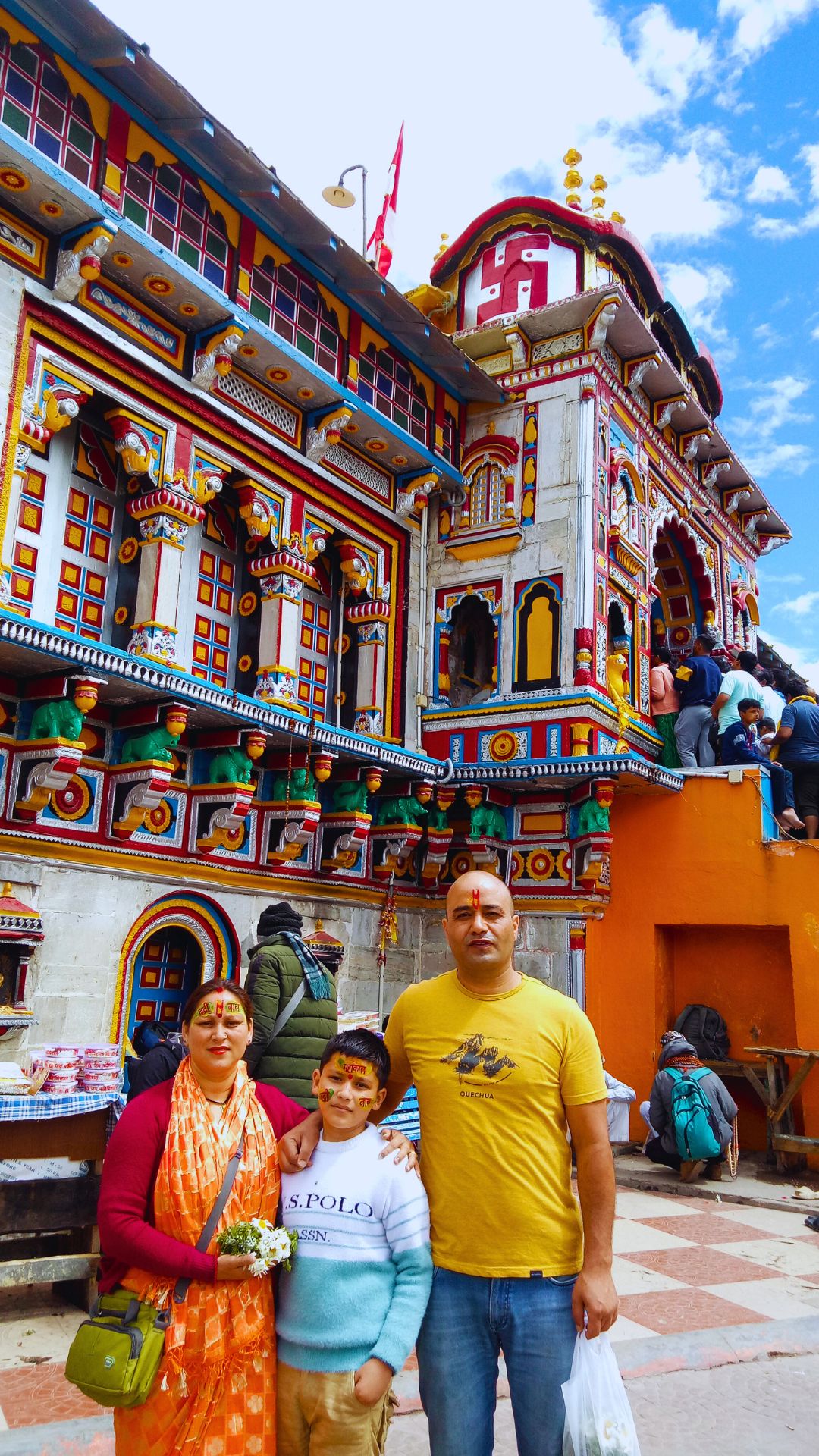Badrinath
Home → Badrinath
About Badrinath
General Info..
Shri Badrinath Dham
Badrinath: A Sacred Journey to the Abode of Lord Vishnu
Nestled in the serene lap of the Garhwal Himalayas, Badrinath is a town that holds immense spiritual significance and natural beauty. Located in the Chamoli district of Uttarakhand, India, Badrinath is one of the four Char Dhams—a pilgrimage circuit that is considered sacred by Hindus. With its rich cultural heritage, stunning landscapes, and profound religious importance, Badrinath attracts thousands of pilgrims and travelers from across the world each year.
The Badrinath Temple: A Spiritual Beacon
The Badrinath Temple, dedicated to Lord Vishnu, stands as the centerpiece of this holy town. The temple, with its vibrant facade and intricate carvings, is an architectural marvel that dates back to the 8th century. It is believed that the temple was established by Adi Shankaracharya, a revered Hindu saint, to revive the Hindu religion.
The presiding deity of the temple is Lord Badri Narayan, depicted in a meditative pose, flanked by Nar and Narayan, his two forms. The temple is open to devotees from April to November, as it remains closed during the harsh winter months due to heavy snowfall.
Location and Accessibility
Badrinath is located at an altitude of 3,300 meters (10,827 feet) above sea level, amidst the Nar and Narayan mountain ranges. The town is surrounded by snow-capped peaks, with the Neelkanth Peak standing majestically in the background, offering a breathtaking panorama that enchants every visitor.
To reach Badrinath, travelers can take a scenic drive through winding mountain roads. The nearest airport is Jolly Grant Airport in Dehradun, approximately 311 kilometers away. The closest railway station is in Rishikesh, about 294 kilometers from Badrinath. From there, one can hire a taxi or board a bus to reach the town. The journey, though long, is filled with picturesque landscapes, rivers, and valleys, making it a memorable experience.
The Enchanting Beauty of Badrinath
The natural beauty of Badrinath is unparalleled. The town is situated on the banks of the Alaknanda River, which adds to its tranquil charm. The river’s pristine waters and the surrounding lush greenery create a perfect setting for reflection and peace.
One of the key attractions near Badrinath is the Tapt Kund, a natural hot water spring located just below the temple. Pilgrims believe that a dip in these thermal waters purifies the soul before entering the temple for worship.
The Vasudhara Falls, located around 9 kilometers from Badrinath, is another must-visit spot. The waterfall cascades from a height of 400 feet and is surrounded by majestic mountains, making it a sight to behold. Legend has it that the water from the falls does not touch those who are impure in heart, adding to its mystical aura.
Things to Know Before You Travel
Traveling to Badrinath requires some preparation, especially given its high-altitude location and unpredictable weather. Here are a few tips to ensure a comfortable journey:
Best Time to Visit: The ideal time to visit Badrinath is between May and October when the weather is pleasant, and the temple is open. Monsoons should be avoided due to the risk of landslides.
Clothing: Carry warm clothing, as temperatures can drop drastically, especially during the evenings. Comfortable shoes are a must for walking around the town and visiting nearby attractions.
Altitude: Being a high-altitude destination, some travelers might experience altitude sickness. It is advisable to acclimatize yourself in the lower regions before heading to Badrinath.
Accommodation: There are several hotels, guesthouses, and ashrams in Badrinath that cater to different budgets. It is recommended to book your stay in advance, especially during the peak pilgrimage season.
Badrinath is not just a destination; it’s a spiritual experience that leaves a lasting impression on every traveler. Whether you seek divine blessings, solace in nature, or a retreat from the hustle and bustle of everyday life, Badrinath offers it all. The combination of its sacred aura and natural splendor makes Badrinath a must-visit for anyone looking to embark on a journey of the soul.
Itinerary: Journey to Shri Badrinath – A Spiritual and Scenic Expedition
Starting Point: Rishikesh | Duration: 4 Days | Main Station: Joshimath
Day 1: Rishikesh to Joshimath
- Distance: ~265 km | Time: 6–8 hours drive
Start your journey early from Rishikesh, the gateway to the Garhwal Himalayas. As you ascend into the mountains, prepare to be enchanted by the pristine beauty of Uttarakhand.
- Route Highlights:
- Devprayag: Witness the sacred confluence of the Bhagirathi and Alaknanda rivers, forming the Ganga.
- Rudraprayag: Marvel at the meeting of the Mandakini and Alaknanda rivers.
- Karnaprayag: A serene town steeped in mythology, where Karna meditated.
Reach Joshimath by evening, the spiritual and logistical base for your onward journey to Badrinath. Take a peaceful stroll to the Narsingh Temple, where Lord Vishnu is believed to reside during the winter months. Spend the night in a cozy hotel or homestay, soaking in the mountain vibes.
Day 2: Joshimath to Badrinath
- Distance: ~45 km | Time: 2 hours drive
After a refreshing breakfast, drive to Badrinath, one of the four sacred Char Dham pilgrimage sites. The journey is a visual treat with towering peaks, cascading waterfalls, and the holy Alaknanda River accompanying you.
- Route Highlights:
- Vishnuprayag: The confluence of the Alaknanda and Dhauliganga rivers.
- Mana Village: India’s last village, where mythology and reality blend seamlessly. Visit attractions like the Ganesh Gufa, Vyas Gufa, and the Bhim Pul over the Saraswati River.
Arrive at Shri Badrinath Temple, dedicated to Lord Vishnu.
- Temple Highlights:
- The iconic black stone idol of Lord Vishnu in a meditative posture.
- Spiritual ambiance surrounded by the Nar and Narayan mountain ranges.
- A dip in the Tapt Kund, a hot water spring believed to cleanse the soul.
Spend the evening soaking in the divinity and serenity of the temple complex. Check into a hotel or guesthouse for the night.
Day 3: Badrinath to Joshimath
- Distance: ~45 km | Time: 2 hours drive
Wake up early to experience the morning aarti at the Badrinath Temple, a soul-stirring experience. Post darshan, explore the surrounding sites:
- Charan Paduka: A rock with imprints believed to be Lord Vishnu’s footprints.
- Narad Kund: The pool where the idol of Lord Vishnu is said to have been recovered.
After a hearty breakfast, begin your descent to Joshimath. On the way, enjoy panoramic views of the Himalayas and the gurgling Alaknanda River.
Optional: Take a short detour to Auli, a pristine meadow famous for its skiing slopes and stunning vistas of Nanda Devi and other Himalayan peaks. Return to Joshimath by evening and relax at your hotel.
Day 4: Joshimath to Rishikesh
- Distance: ~265 km | Time: 6–8 hours drive
Conclude your pilgrimage with a scenic drive back to Rishikesh. Reflect on the spiritual experiences, mesmerizing landscapes, and profound serenity of your journey.
- Optional Stops:
- Shop for local souvenirs and handicrafts in Karnaprayag or Rudraprayag.
- Relish local Garhwali cuisine along the way.
Best Time to Visit
- Summer (May to June): Pleasant weather with blooming flora.
- Post-Monsoon (September to October): Clear skies and rejuvenated landscapes.
Travel Tips
- Clothing: Carry warm layers, even in summer, as temperatures drop at higher altitudes.
- Health: Stay hydrated and carry basic medications for altitude sickness.
- Permits: Ensure you have all necessary travel permits if required.
- Footwear: Comfortable shoes for short walks and temple visits.
This thoughtfully curated itinerary combines spiritual solace with the unparalleled beauty of the Himalayas, promising a journey to Shri Badrinath that will leave your heart full and soul enriched.



